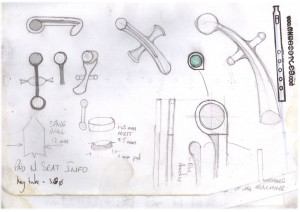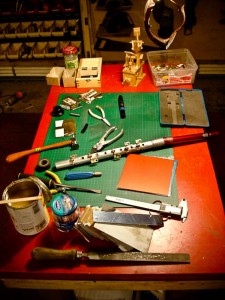I always found it amazing that there wasn’t some form of chromatic whistle. I mean this is arguably the worlds oldest melodic musical instrument. Why would it be left out when almost all the other commonly thought of musical instruments are Chromatic. The number of times that I’d be playing, the music would change key and I’d have to pick up a different instrument, or awkwardly half cover a hole to play a note which sat outside the key. I only ever wanted one whistle – a tried and tested friend that I could take anywhere.
I’m pretty sure I started making musical instruments just to be able to make this Chromatic Whistle that I wanted to play. But you certainly can’t make a nice Chromatic Whistle without making a great ‘basic’ one first. And so went 10 years of my life; filing, turning, banging, gluing, polishing, crafting, I worked long hours, often through the night to come up something of the highest quality that my hands, eyes and ears would allow.
 Early sketches were based on a revised version of the Boehm key system – as used on metal Flutes, Saxophones and Clarinets. But the more I looked at it, the more I realised that this heavily mechanised system was a product of the great age of mechanisation, and perhaps in an age where mechanics seemed to be the solution to everything, instrument designers had adopted it too enthusiastically. I thought it might be possible to something simpler and more elegant, and working with the mechanics of the hand. Even so, it was just an concept – I never expected it to work! But early prototypes surprised me – not only could I leave the original architecture of the instrument intact, but the extra notes notes didn’t seem to involve movements that were too awkward.
Early sketches were based on a revised version of the Boehm key system – as used on metal Flutes, Saxophones and Clarinets. But the more I looked at it, the more I realised that this heavily mechanised system was a product of the great age of mechanisation, and perhaps in an age where mechanics seemed to be the solution to everything, instrument designers had adopted it too enthusiastically. I thought it might be possible to something simpler and more elegant, and working with the mechanics of the hand. Even so, it was just an concept – I never expected it to work! But early prototypes surprised me – not only could I leave the original architecture of the instrument intact, but the extra notes notes didn’t seem to involve movements that were too awkward.
 The whistle is an instrument which has always survived on the fringes of society – with it’s simple charm it has been adopted by cultures all the way round the world. The challenge in designing and making the next generation might be trying to maintain the character of the instrument (and the music played on it).
The whistle is an instrument which has always survived on the fringes of society – with it’s simple charm it has been adopted by cultures all the way round the world. The challenge in designing and making the next generation might be trying to maintain the character of the instrument (and the music played on it).


7 replies on “A Chromatic Whistle?”
“Interesting” … (in a positive way) 🙂
If I were to go for a keyed whistle it would be of minor importance what it looks like … so not to worry too much about it.
What counts for me is how easy and fast can I reach the keys. (I have made some bad experience with keys on my Uilleann Pipes chanters)
The simple flute key systems appears to be a reasonable compromise and why not reuse a working design?
The keys on my Ormiston flute are really excellent.
Best of luck and I would certainly be interested in trying a keyed whistle.
Joachim,
Some very good points there. I absolutely agree about the importance of functional aspects of musical instruments, but I also place considerable weight on the visual appeal. When I taught in schools I came to notice the way the children were drawn to certain instruments – and how they looked definitely played a part in this. The truth is that in so many great designs the optimal functional design also leads you to something with a fantastic form – take the saxophone, violin or guitar as examples.
Yes I looked at the Simple key system, as well as the Boehm system. Both are fantastic while also being flawed, as any system will be. We only have 9 effective fingers (one to balance the instrument) to make 12 notes. [ In an ideal world we’d have evolved with 13 fingers! ] The opportunity to put a key system on a whistle offers an opportunity to try something new – putting a new key system on a saxophone or wooden flute would mean that musicians would probably reject it in favour of the system they’re used to. Jim Schmidt might be an example of someone who is swimming directly into this stream >> http://users.gotsky.com/jimschmidt/default.html.
Why not make something unique to the whistle, and that also maintains it’s character? Let’s throw the doors open and see what we come up with.
I’ve shown George one of the very early prototypes and he seemed to agree with me there was quite a lot of scope for this new system. There’s a picture of him inspecting it here >> http://www.mkwhistles.com/wp-content/uploads/2010/07/George-Ormiston-inspects-mk-toob-chromatic-whistle.jpg
Misha
Hi Misha
I like the idea of the design. Two additional thoughts:
1. On the mock up (like a flute) you have the structures holding the key mechanism on the top plate of the whistle. Although I obviously have not held the design I suspect that there may be some issues of the existing fingering pattern (pipers grip) in terms of having to modify the hands to get “around” elements of the structures (given that everyone has different sized hands). My suggestion is to place the structure on the underbody of the whistle (ie., the mechanism which holds the keys). This would leave the top plate free with only the lever for the keys in reach. Bascially it would be an upside down structure to what you have. It would also look more pleasing as all you would see when playing would be the levers and the keys covering the additional holes.
2. The other idea would be to develop a low whistle “headjoint” for concert flutes. This would give flute players the opportunity to have a low whistle sound. This is an idea of mine which I would be happy to develop with you.
I am happy to help you develop the “keyed” low whistle and headjoint if you wish.
Raymond,
1. A very good point with regards the support structure. You are absolutely right and this is still something we have yet to resolve – you’ve obviously got a good grasp of the issues involved. We’re actually going to take a look at some fresh ideas on how the keys can operate, and post things as we go – would be great if you keep tuned in.
2. At the moment we’re working on getting whistle players a great instruments to play. You never know, at some point in the future we might take a look at adapting flutes – but we’ve got our hands full for the time being!
Hi Misha,
I love the idea of a keyed whistle. It sounds like you’re looking for feedback, so I hope you don’t mind some.
I’m an Irish flute player, and the first thing I notice is the location of the key touches will require me to learn new fingering. This makes the TOOB much less appealing. I think Irish flute players will make up a large percentage of your buying market, so it’s something to consider. Bb and Cnat might be a little tricky to place, but otherwise it wouldn’t be too hard to do.
I’m also a little concerned with having the pivots in between the holes. I bet my thick fingers will bump against them.
Otherwise, I hope this works out. I might like to own one once the design is refined.
Hi, I came across this site whilst looking for a Low Bb whistle. I love the idea you have of a chromatic whistle.
I need a good Bb flat whistle to play along with my husband when he practises his bagpipe chanter which is only in Bb, But I also play guitar, keyboards harmonica Tenor drum,etc and wish I had a whistle that I could use alongside my recordings and my mans songs.
come on your taking the fun out of all we semi-literate-play-it-by-ear-jangly-bag-full-of-whistles-oh-no-the-tunes-finishing-and-i’ve-only-just-found-the-right-whistle Players….
shame on you…..
btw are you going to start making whistles in any other keys?